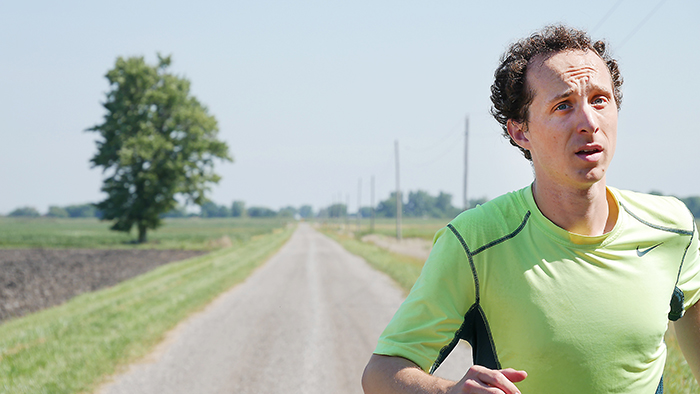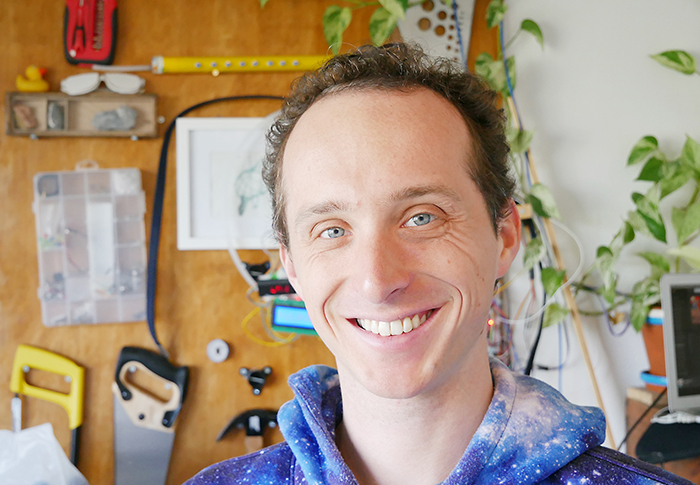
Chatham-Kent native Kurtis Baute has gone from using thousands of dominoes to chart the history of the universe to detailing the evolution of man while running a marathon.
What goes on in the YouTuber/scientist’s head is never boring.
A year ago, Baute, 29, placed 13,799 dominoes on the floor of his parents’ Maizex Seeds warehouse near Jeannette’s Creek and toppled them one after another while detailing the history of the universe, starting with the Big Bang Theory and ending at present day.
Since then, he’s released about a video a month using quirky methods to showcase scientific principles and real-life experiments, including creating a one-man bio dome in October, and more recently charting mankind’s 42-million-year existence on Earth by running a marathon, a distance of 42 kilometres.
“It took four hours and 39 minutes to run. I had the script memorized, but it just blew my mind that I took 43,000 steps, and my whole lifetime is the length of my shoe,” he said. “What’s more, all of written history is the last minute of running. That’s astounding, especially when you think of how much progress we’ve had in that minute.
“We spent 40-something kilometres (40-plus million years) figuring out how to make a wheel, and in 66 centimetres we go from flying to landing on the moon. That’s wild.”
Baute filmed his dialogue for his marathon right here in Chatham-Kent as he jogged along many a stretch of back road. He said it was the perfect location.
“I couldn’t film it here (he calls Vancouver home now) because I can’t just run behind a car in the city for four hours,” he laughed.
While running the marathon got Baute’s heart rate up to an average of 130 beats per minute, he was surprised to see that stepping out of his bio dome experiment spiked his heart rate to a similar number.
“I came out and my heart rate was 130 (beats per minute). That’s incredible. It’s something I wasn’t really prepared for,” he said, adding his rest rate is 59 beats per minute. “I felt the air rush in and my body was working as furiously as it could to get oxygen into my system.”

When Baute came out of his bio dome, the carbon dioxide levels had risen to 10,000 parts per million. His CO2 monitors couldn’t register anything higher, and warned him the air quality was poor. Shortly afterwards, he terminated his experiment.
Baute had originally hoped to spend as much as three days in a three-metre by three-metre plastic cube to showcase how we need to manage the air we breathe. Instead, he lasted about 14 hours.
The big problem for Baute was when the sun rose on his experiment, it was obscured by heavy cloud cover. His 10 small trees and estimated 100 other plants he’d brought with him into the cube didn’t get enough sunshine to scrub out the CO2.
But at no time was he in any physical danger. Baute said the oxygen levels, typically at about 21 per cent in normal conditions, dropped to 19.6 per cent at its lowest. Even with the lack of sunlight, the plants were producing oxygen, as the levels began to rise.
“I was really excited; it did start to creep back up,” he said.
But the CO2 levels continued to rise as well.
“It’s a lot to ask,” he said of what the plants needed to do to keep the CO2 levels in check. “There’s a tipping point. If carbon dioxide gets too high, it’s difficult for plants to do their work. They are kind of suffocating.”
Baute conducted the bio dome experiment Oct. 24. He said he avoided the summer months because the sunshine would have turned his cube into an oven. Even on a fall day, had it been a clear, sunny affair, it would have become quite warm in the cube.
“One day when I was building in there, the sun hit it for about an hour and a half, and it shot up to 34C in there, and the box wasn’t even closed,” he said. “If we had got a ton of sun, I would have cooked.”
Baute had hoped for a day of intermittent cloud, but that never materialized.

Despite the shorter than anticipated stay in the cube, Baute said it was quite the experience. He garnered news coverage from outlets such as the CBC and BBC, and was trending on Twitter.
Through it all, he was filming his own videos and making sure he was safe. What he finds scary, however, is how many people around the world think nothing of elevated CO2 levels.
“I have a masters in environmental science, but I am floored by the levels of carbon dioxide in big cities and small spaces. It affects how we can think,” he said. “In cities such as Deli (India), it is incredibly polluted. It’s shortening people’s lives by years. It’s like smoking, but you are just breathing in the air.”
Baute said the bio dome experiment had a simple and safe conclusion. In the video he said bluntly, “When something goes wrong in here, I can just cut my way out,” something that we can’t just do on a global level.
“We are not managing it very well. We are emitting carbon dioxide and a ton of other air pollutants and these are contributing to things like climate change,” he said.
But Baute stressed we can all do a little to help have a positive impact. People can contribute in three simple ways, he said – flying and driving less, eating less red meat and using their vote to start a conversation about climate change.
Flying and driving burn fossil fuels, while producing meat for human consumption is a big CO2 problem as well, Baute said. Reports have cattle production eclipsing cars in terms of greenhouse gas emissions.
It’s Baute’s goal to release a video per month relating to science. For him, coming up with concepts is not an issue. Sorting through them all is.
“I have a huge list of ideas. Coming up with them is a problem in the opposite way. Last night, for example, as I was trying to go to sleep, I couldn’t stop thinking about pendulums and gravity. These things keep me up at night,” Baute laughed. “We live in a world of wonders.”
In some ways, Baute never grew up, and that’s a good thing. He said we humans are typically extremely curious as children, but eventually we stop asking “why” all the time.
“Questions kids ask are less complicated, but no less wondrous,” he said. “I think we eventually bury that curiosity. Wondering about the colour of the sky is a cool thing.”
These days, Baute is trying to answer various questions via video response and experimentation.
“Every month is very different. If I get tired of setting up dominoes, the next month I’m building a giant binary lightning flute,” he said. “I built this instrument and spent a full month trying to learn how to play some simple songs with it. These are the sorts of things I do.”
Who else would build a flute where a person plays it and creates lightning and sound via a Tesla coil?
 Baute has also used his bicycle and two sundials
Baute has also used his bicycle and two sundials
to measure the size of the Earth, and to prove the world is round. This past summer, he travelled to Regina, Sask. and set up one sundial in the city before heading out on Highway 33.
“I biked 138 km down one of the straightest, longest roads in the world. I used the difference in the lengths of the shadows (of the sundials) to measure the size of the Earth,” he said. “If the Earth was flat, they’d be the same size.”
That video got thousands of comments on it, many of which came from people who still believe the Earth is flat, he said.
As for what Baute will be focusing on in his videos in 2019, he declined to give away any exact details, but said there will be more projects about the environment.
“But I am also just fascinated by science. I want people to have that experience. It’s a positive thing,” he said.
To check out more of Baute’s YouTube offerings, click here.






